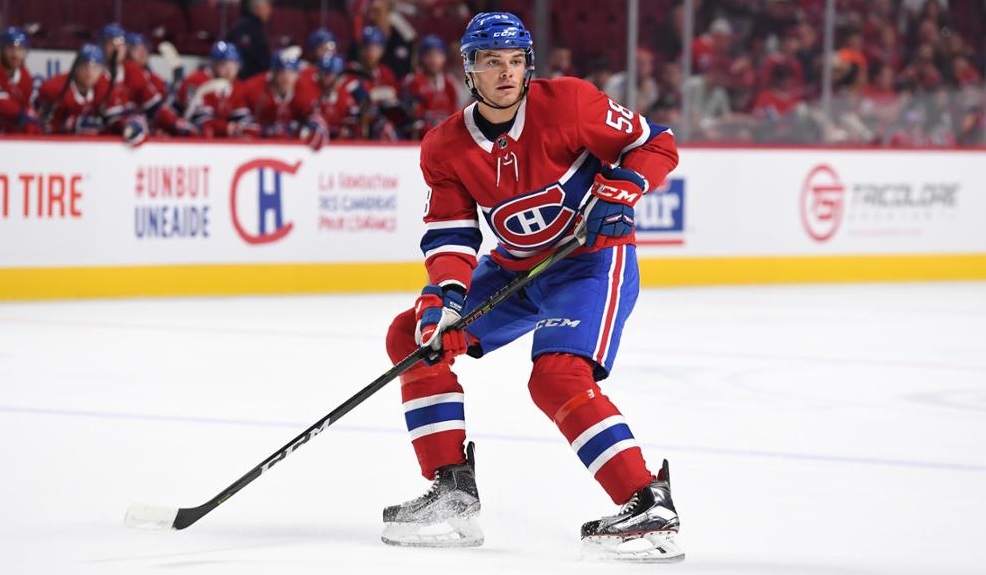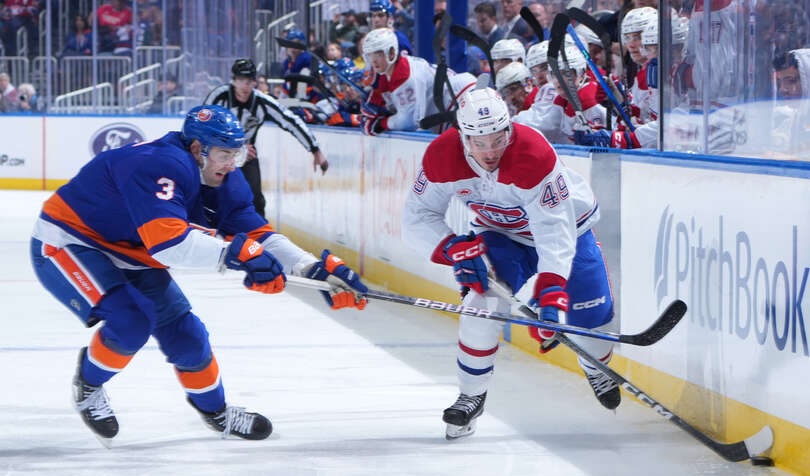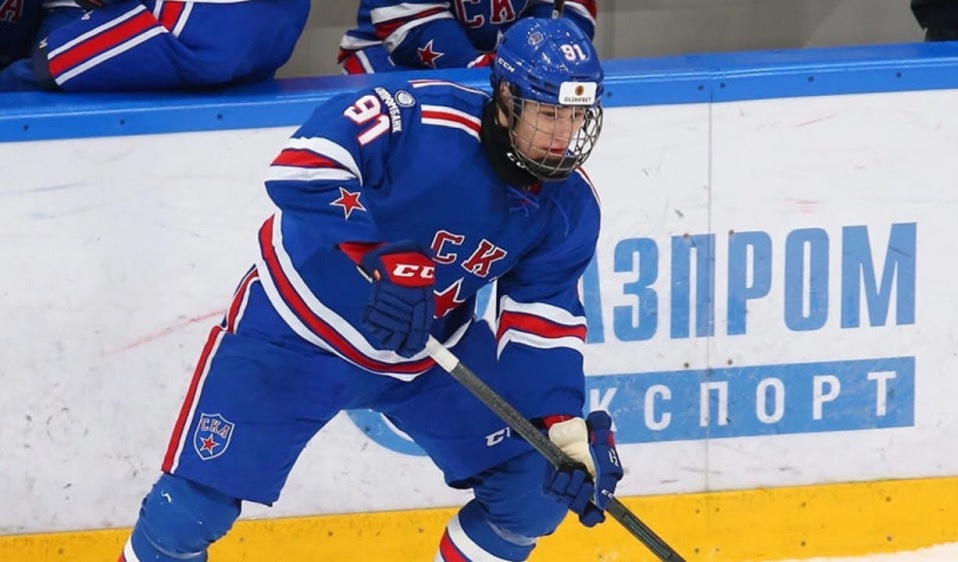HabsWorld.net --
Whenever I listen to a certain Montreal sports radio station, it constantly plays an annoying commercial from a transportation company that asks its listeners to make a connection between a series of seemingly random, unconnected products, and what do they all have to do with shipping. The announcer then says, “Nothing.”
Now if I were the change the wording of this ad to an NHL theme, it would be,
“What does Montreal’s recent re-signing of Noah Juulsen to just a one-year contract, this year’s NHL Draft and COVID-19 all have in common?”
I’d respond by saying,
“A LOT.”
These seemingly unrelated events are actually tightly connected by the theme of denied development time. I am very worried that as a result of the COVID-19 lockdowns, this year’s NHL draft will be more of a crapshoot than a vintage one as most pundits have assumed. There is a reason Montreal traded a number of its picks to next year. There is a good chance that many of the players selected this October, might developmentally wither on the vine.
Having said this, there are solutions to remedy my concerns but they need to be quickly acted upon. What the Montreal Canadiens (or any other NHL franchise) can’t do, is sit back, let things be, and hope for the best.
The graduating draft class of 2020, will, and already has been, denied crucial playtime – meaning that a number of them could unnecessarily become busts.
And this is where Noah Juulsen fits into my seemingly unconnected ad copy. Juulsen, through no fault of his own, has missed crucial development time. So much so, that his once bright future MIGHT have – let me emphasize the word MIGHT here – significantly stunted his potential.
In 2015, every indication pointed to him one day becoming a quality, perhaps top 4 defenceman. Now, though, I’m not so sure about his upside. And the Canadiens’ first-rate pro scouting staff must share these same doubts as he was only signed to a one-year contract. This is not a good sign for Juulsen’s future.
Young professional athletes need crucial competitive playing time. Taking two pucks to his face in one game back in November of 2018, followed by a long period of zero game action, denied Noah Juulsen this precious time.
I could be totally wrong in my speculation here – and I sincerely hope for this young player’s sake that I am – but let me explain how this freak event and his subsequent long absences from hockey relate to this year’s draft. I’ll begin with two non-hockey analogies starting with high school genetics followed by linguistics.
Pretty random sounding wouldn’t you say? Hang in there. I have to go outside of hockey examples because something like COVID-19 has never happened before in this sport so to answer how it might impact player development, we have to look at relatable outside examples. Trust me, I’m not being random for randomness’ sake. It’ll all make sense. Just bear with me by starting with a discussion on genetics.
Way back in grade 10, I learned about the concepts of genotype and phenotype. There is genetic, innate potential (genotype) and then there is realized potential due to environmental influences (phenotype).
An apple tree will only grow so high. A Douglas fir grows a whole lot more. That’s genotype. Genes play a huge role in terms of the height of tree species. Now deprive these trees of water, nutrients and sunshine and they never will reach their phenotype/potential.
Being drafted with lots of potential is only 1/3 of what an athlete will become. His psychological make-up and development constitute where he finishes.
Elite professional athletes are also like people who have a special knack for languages. That is, there are some people who come to a foreign language speaking country at the age of 18, and often learn to speak this tongue accent-free. They sound as native as any native speaker. If, however, they, despite their linguistic giftedness arrive a few years later, they’re still very good in their command of the language but not “elite” in their accent. Athletic development time is a lot like this.
The final touches to being great at any sport are learned during a very small window of playing time. If you start your training when the window of opportunity closes, the odds of elite success is not in your favour. Just ask Michael Jordan who quit basketball and tried to become a baseball player.
Genetically speaking, Jordan had the genetic makeup of an elite athlete. He had put in a ton of time learning this sport prior to going all-in in basketball. And his psychological mindset for success was off the charts incredible. Unfortunately for MJ, though, he re-took up this sport two years too late. The window of opportunity for his brain to coordinate his body to swing a bat while tracking a 100 MPH fastball had closed and he was confined, at best, to being a minor leaguer.
No amount of genetic potential or incredible determination would change Jordan’s baseball fate. He needed development time and it had to happen prior to a certain age. He had the equivalent of a slight “athletic accent” that could not be removed.
Phenomenal success and lack of success in any professional sport is determined by fractional differences. The fractions were simply not in Jordan’s favour.
Now here’s how all of these analogies all relate “A LOT” to this year’s supposed “vintage” NHL draft.
I have a bad feeling that some of the “grapes” have been pulled too early or that many of the drafted players will, if an intervention is not made, wither on the vine.
These draft picks have been denied crucial playing time thanks to the COVID-19 lockdowns. Skills and development coaches are less available. Junior hockey leagues are facing development depriving government oversight. In Ontario, home of most of the OHL, for example, the provincial government announced a ban on checking to promote additional social distancing. “Normal” development is not happening across the board.
Many of these prospects have already missed the Memorial Cup at the prime of their junior careers. This tournament is essential for development. The best need to compete with the best in order to grow. As wise King Solomon once said, “Iron sharpens iron.”
Imagine what would have happened to Nick Suzuki, both psychologically and from a skill learning perspective, if he had missed both 2019’s Memorial Cup – which he dominated in – as well as his impressive play in this year’s Stanley Cup playoffs?
You can only do so many drills to be great. Intense game action learning is absolutely vital for player development.
Taking a year off from such critical interactive play at the age of 18-19 is like being deprived of speaking a language for a year and trying to compensate by watching TV shows. These athletes NEED to play.
Imagine if the Beatles took a forced year or two break from music after producing the album Revolver; or they if they never got to compete with Jimi Hendrix and the Beach Boys? I seriously doubt that there would have been Sergeant Pepper. Iron sharpens iron.
Now some of you will argue that the NHL had a year-long lockout and there was no major impact on the quality of play. True, but this is comparing apples and oranges.
Most of the players that weren’t playing were fully developed products. They were not denied key development time. They had no “accents.” And they had produced their “Sergeant Pepper.” Young prospects like Sidney Crosby and Carey Price were still honing their skills in the junior leagues.
Some of you may recall Team Canada during the 2007 World Juniors and Price being between the pipes. Price was given a chance to shine, which he did. His outstanding performance during the nail biter championship game did wonders for his long-term development. This is what real, intense game action does.
I believe that General Manager Marc Bergevin and his scouting staff understand this concept of delayed development in this year’s draft. This is why both he, and his head scout, Trevor Timmins have repeatedly stated the importance of “character” in their 2020 selections – significantly more than they usually do.
It may fully explain why they drafted a very safe pick in Kaiden Guhle at number 16. There is a greater chance that highly determined players such as Guhle, may be able to overcome the challenges brought on by the COVID-19 lockdowns.
Back in March, the consensus was that 2021 would be a weaker draft. Why would Bergevin and company put more stock in 2021 unless they too see the writing on this year’s wall? I believe that the Montreal Canadiens were hedging their bets this October, hoping to once again enterprise on the after-effects of COVID.
Some other telltale indicators of this being a crapshoot of a draft was Montreal’s – and all other franchises, except Arizona’s – forced reliance on video in terms of making their selections.
Nothing beats live scouting. Video does not capture the full speed of the game. It does not reveal the nuances of real live, in-person action. Back in the 2000s, to save money, the Buffalo Sabres fully embraced video and paid a huge price for this failed experiment.
The Canadiens knew that this go-round, many of their picks were going to be like throwing darts to a board and this was why they kept saying the word “character” over and over again. This was the only thing that they could properly measure.
So, if development time is the rate-limiting step in this year’s draft then the next logical step that the Montreal Canadiens need to undertake is to come up with a way to get their prospects safely playing at a high level. And they need to act quickly on this critical manner because the window of opportunity is closing.
What this franchise needs to do is help establish a COVID-19 bubble academy where its prospects are safely sequestered. It would also be a good idea if it could also bring in additional competition by opening up its academy bubble with a non-rival franchise from the Western Conference. This would help to facilitate intense game action.
My favourite pick to partner with the Canadiens is the Colorado Avalanche which is also prospect rich like Montreal. Of course, convincing all levels of government to allow such a joint venture would not be easy. If Colorado is not permitted, then Vancouver would be my second choice. From a talent perspective, Ottawa would be ideal but I fear that a number of prospects on both teams would likely get hurt as this seems to always be the case whenever they get together in preseason matches. With the Quebec government not permitting the opening of Montreal’s training facilities at the moment, the Canadiens would have to have their prospects travel for something like this to work. Hopefully, young AHLers would also participate to further increase the skill levels in these competitions. Iron, then, will indeed sharpen iron.
Imagine the competitive edge that both these franchises would get by having such academies. There would also be cost savings in having them co-host this training bubble. Without a doubt, such an initiative would be money well spent. Perhaps, games could be televised and revenues for the broadcast rights could be used to subsidize these academies.
Marc Bergevin has been extremely decisive, enterprising and aggressive in navigating through the muddy waters of this COVID-19 altering season. Now he needs to fix this development matter. And, he needs to do this fast.
The worst thing that the Habs can do is sit back and hope that their “character” draft picks will make-up for their lost development time on their own.
The Montreal Canadiens need to ensure that this year’s “vintage” draft crop is fully realized. The easiest solution to fix things is by creating a COVID-19 bubble academy.
So, what does Montreal’s recent re-signing of Noah Juulsen to just a 1-year contract, this year’s NHL Draft and COVID-19 all have in common?
Clearly, A LOT.
Now would be a bad time to let things just be.


